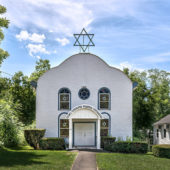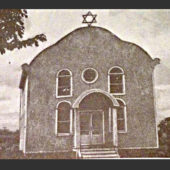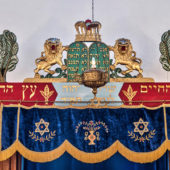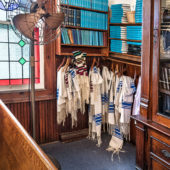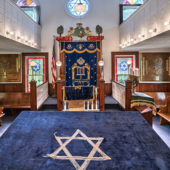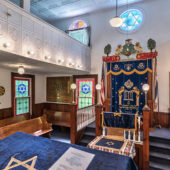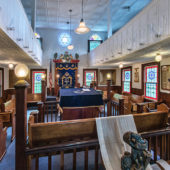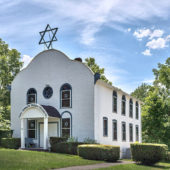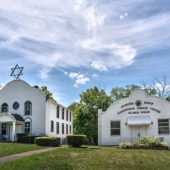Listed on the National Register of Historic Places, representative of an early 20th Century Catskill Mountain area synagogue.
Congregation Tifereth Yehuda Veyisroel was originally established in 1922. The synagogue building was dedicated in 1924. The adjacent community building now serves as a Talmud Torah, unusual for a congregation of only about 60 families. It is an egalitarian community whose members come from a variety of Jewish backgrounds. The Community Center hosts an active Seniors Group. There is a cemetery for our members and their families.
The synagogue was listed on the National Register of Historic Places on August 27, 2013. The National Park Service listing description of the synagogue:
“Congregation Tifereth Yehuda Veyisroel Synagogue is significant as a representative intact example of an early twentieth century vernacular synagogue in New York’s Catskill Mountain resort region. The building was constructed in 1924 to serve Jewish farmers and merchants in the small Ulster County hamlet of Kerhonkson and the immediately surrounding area. Primarily immigrants from Eastern Europe, the newcomers were part of a wave of thousands of Jewish farmers who relocated to a small area of Ulster, Sullivan and Delaware Counties in the 1910s and 20s to avoid persecution in their homelands.
One of approximately twenty surviving synagogues built in the Catskills before 1950, the building is typical of the type, combining decorative and functional features characteristic of eastern European orthodox synagogues with forms and materials typical of regional vernacular architecture. As is characteristic, the Kerhonkson synagogue is a rectangular building, three bays wide, with a Baroque-inspired parapet on the facade. Like others of the type, it was originally clad in stucco on all four sides (the facade is now concealed by asbestos shingles) and features opaque and colored glass windows incorporating Hebrew symbols.
The interior features a vestibule and sanctuary and a traditional orthodox plan, defined by a central bimah with pews facing it on three sides, an ark, and a gallery on three sides that originally provided separate seating for women. Like others in the set, the Kerhonkson synagogue was constructed with stock building materials, such as standard moldings and pressed tin, creating a space that is both similar to the regional architecture of the period and evocative of ancient religious traditions. Congregation Tifereth Yehuda Veyisroel Synagogue has been the spiritual and social center for Kerhonkson’s Jewish community for nearly ninety years. The nomination also includes the c1954 Community House, which was constructed as a social hall and Hebrew school. Both buildings retain a substantial level of integrity.
The building features narrow corner boards and is surmounted by a gable roof with overhanging eaves; however, the facade features a false front that extends above the roof. This feature, common to early twentieth century synagogues in the Catskills, takes a tripartite, Baroque inspired form consisting of three curves. It is embellished on either side by large, serpentine, bracket like forms; these decorative pieces spring from the eave lines.
Jewish Settlement in the Catskills
Jews settled in the Catskills as early as 1720, when Louis Moses Gomez, a Sephardic Jew, settled near Newburgh to trade with the Indians. Jewish peddlers, primarily of German extraction, abounded in the area in the early nineteenth century and, in 1837, an experimental Jewish communal farming community was established at Sholam, northwest of Ellenville. This community failed and at least one of its residents relocated to Ellenville. However, most late nineteenth century Jews in the region were not farmers and it would be another half century before Ellenville became a center of Jewish agricultural activity.
Around 1900, Jews emigrating from eastern Europe began to settle in the Catskills in order to pursue agriculture. Many of them had arrived in the overcrowded New York metropolitan area and were encouraged to relocate to the Catskill Mountains by resettlement societies. As they arrived, many with no farming experience, they often purchased unprofitable land from Christians. Their inability to profit from this land sparked the development of the resort economy, as farmers began to take in borders (and later build hotels) to make ends meet. In 1908, one source reported that of 648 Jewish farms in New York State, 500 of them were in Sullivan and Ulster counties.2 This new settlement group was attracted to the area known as the “lower Catskills,” an area between the Shawangunk Mountains and the high Catskills, because of its proximity to New York City, easy access via railroad and the more congenial environment created by its growing Jewish population. The area between Kerhonkson and Ellenville in Ulster County and Woodridge and Woodbourne in Sullivan County was particularly active, said at one time to support one thousand Jewish households. This area developed an active, interconnected Jewish community, forming ties through social organizations, schools, synagogues and shared cemeteries. The establishment of several Jewish aid societies (such as the Jewish Agricultural and Industrial Aid Society) in Ellenville ensured that community’s prominent role in the lives of the region’s Jewish farmers. “

